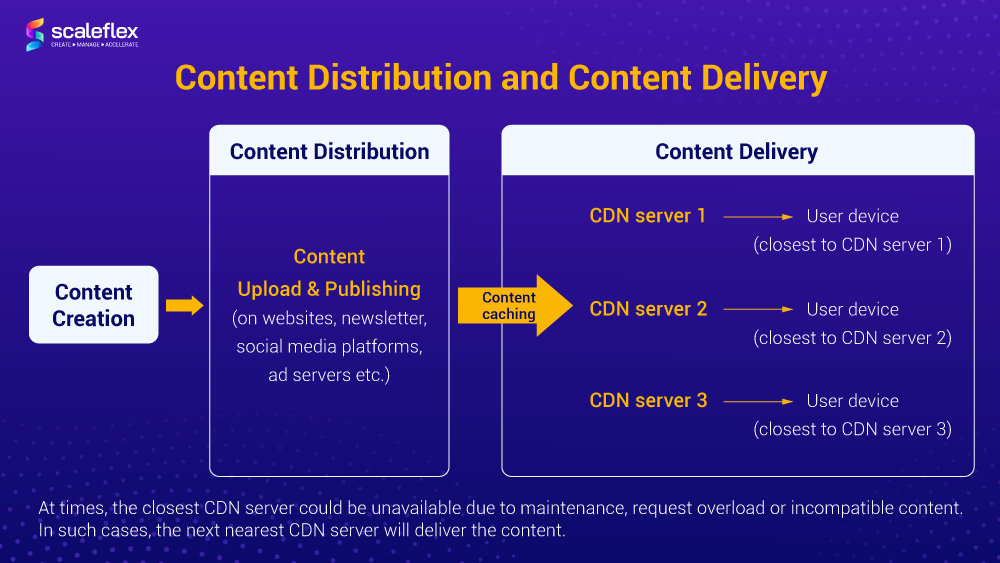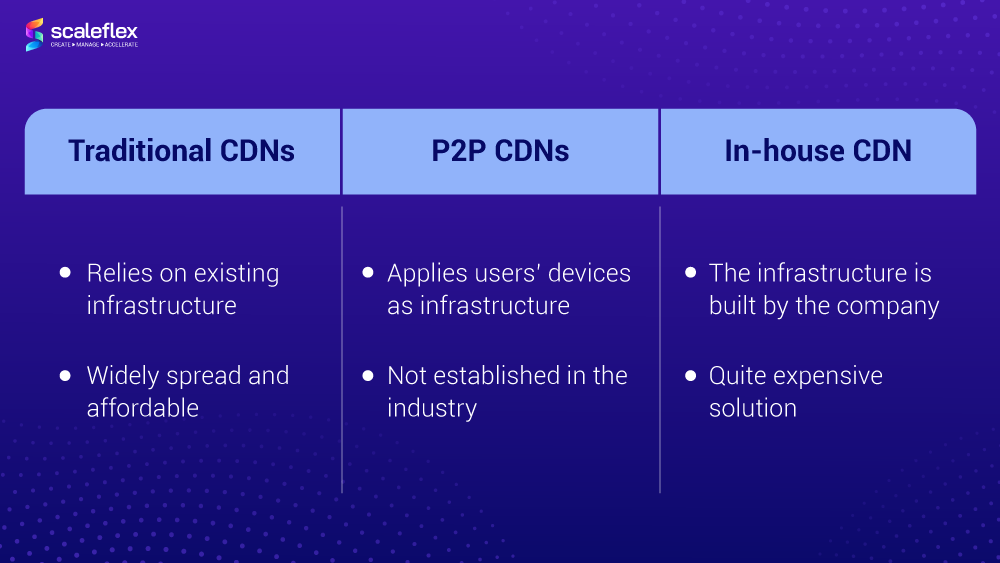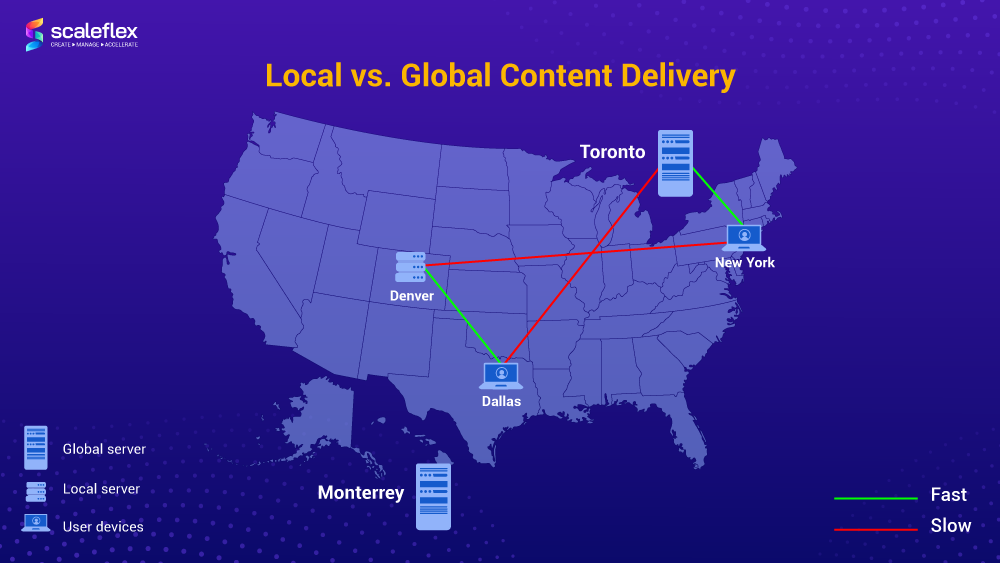Content Delivery Strategies And Methods
Whether you’re watching YouTube videos, reading blogs, or listening to podcasts, you’re consuming content that has been carefully planned, created, edited, and served. It all feeds into something known as “content delivery”, a name given to the process of distributing content with a view to providing a better service for the end-users.
What Is Content Delivery?
In simple terms, content delivery is the act of delivering content (articles, videos, guides) to end-users. It’s the process of distributing content over a large geographical area to hasten page loads and improve the user experience.
On a large scale, content delivery techniques are often performed in conjunction with a Content Delivery Network (CDN). The CDN serves bulk content in a highly-optimized manner and is perfect for a digital content delivery strategy.
Content Delivery vs. Content Distribution

The terms “content delivery” and “content distribution” are often used interchangeably. At the same time, however, “content distribution” is more commonly used to refer to the sharing of content that has already been published.
“Content distribution” refers to what happens to the video once it gets delivered, picked up by news sites and receives reposts and shares on social media.
The distribution aspect can also include paid ads and organic search engine traffic.
History Of Content Delivery
The very first content delivery network was conceived in the 1990s, not long after Tim Berners-Lee invented the World Wide Web.
At the time, a lot of content was being created and experts were concerned that the internet wouldn’t be able to handle it. Akamai Technologies created the first true CDN and this followed on the back of server farms and other early iterations of CDNs.
At the time, most content was served on very basic websites. Images were few and far between, videos were practically non-existent, and everything consisted of text and basic layouts.
Content was still king, but it ruled over a very primitive empire.
Most websites focused on keyword stuffing and the highest Google rankings went to the sites that could find the most exploits, as opposed to the ones that produced the best content.
After a decade or so, internet speed quickened, users have become more demanding, and CDNs were more common. The content was still heavily text-based, but images and Flash games added some variety and increased the complexity of content delivery strategies.
By the 2010s, most of the regions across the world were connected to high-speed broadband and CDNs have grown exponentially, going from processing hundreds of megabits per second to dozens of terabits per second. Their capacity has also evolved to the point where they were handling trillions of transactions every day.
Basic Techniques For Delivering Content
Content Delivery Networks work by placing cache servers at key access points all over the world and then redirecting user device requests to the nearest server.
The user visits the site, triggers the routing code, and is then directed to a nearby server. The location of the server, along with the fact that it has cached the website data, allows it to deliver the content instantly.
CDNs use a variety of different methods to achieve this goal, including HTTP redirection (a redirect request made by the website), IP redirection (based on the individual’s IP), and DNS redirection (a redirection based on DNS hostnames). These content delivery methods provide similar benefits and work to the same goal, but the redirection method varies.
CDNs As The Ultimate Solution
CDNs are the ultimate solution for large-scaled projects. They are designed for companies that have a lot of content to deliver and want to provide the best possible user experiences.
Check out this article to understand how CDNs work and why they are essential for secure content delivery.
There are a few different types of CDN to consider.

The most common type is something typically referred to as a “standard CDN” or just a “CDN” . It redirects users to a nearby server and delivers content as needed. Most of the content is taken from the cache and the rest is sent by the original server before being stored locally for future use.
All of this happens in an instant and ensures rapid page loads. What’s more, as these servers exist all over the world, is that the website can satisfy the high-speed needs of its users.
P2P networks work by connecting users and using them as local hubs. The CDN looks for a user that is part of the peer-to-peer network and doesn’t need to rely on the presence of local servers.
P2P CDNs don’t require lots of infrastructures as they rely on individual users bringing their own resources into the system.
In-house CDNs have been created specifically by a company with the goal of serving its content. These networks are used by major companies like Netflix, as they need to stream high-quality content to users all over the world and can’t rely on third-party providers to do the legwork for them.
CDNs are not cheap. There is a lot of infrastructure and maintenance involved. As a result, in-house CDNs are out of reach for most small-to-medium companies and are typically reserved for massive content brands and streaming giants.
Local vs. Global Content Delivery
There are two main ways to serve content to a user: locally and globally.

Local content comes from a single server and delivers all of the content to a user, regardless of whether it is needed or not. It’s the most common method for small-scaled operations and it has its benefits, but it is also severely limited.
If your server is based in Denver/US, and you’re delivering content to a user in New York/US, it may take several seconds for them to fully load the website and receive the content. That might not sound like too much time, but a wait of a few seconds is usually enough to send your users packing.
Even if the traffic is mainly domestic, the local server solution might not be the best one for big countries, where using servers in neighboring countries might deliver the content faster.
A global content solution, on the other hand, delivers only what is needed and uses servers all over the world to do so. It will find the server closest (for example Toronto/Canada) to that New York user and load the content from there, ensuring it opens quickly.
Global solutions are more expensive and so they aren’t suitable for all websites, but they are certainly the better option for most, especially for businesses with a significant share of international traffic.
Conclusion
A secure and fast content delivery strategy is an essential component of any online business, whether you’re building a personal brand or launching an online business.
You create it, and your visitors will come, but only if they can find it first!
To ensure your content gets to where it needs to go, consider a high-quality cloud content delivery partner like Cloudimage. It’s the fastest and easiest way to optimize your content (including images and videos), boosting your SEO rankings and improving your user experience at the same time.
Cloudimage optimizes all of your digital assets and then delivers these through global CDN partners. To learn more, check out this guide on Available Features to Optimize your Images with Cloudimage.





